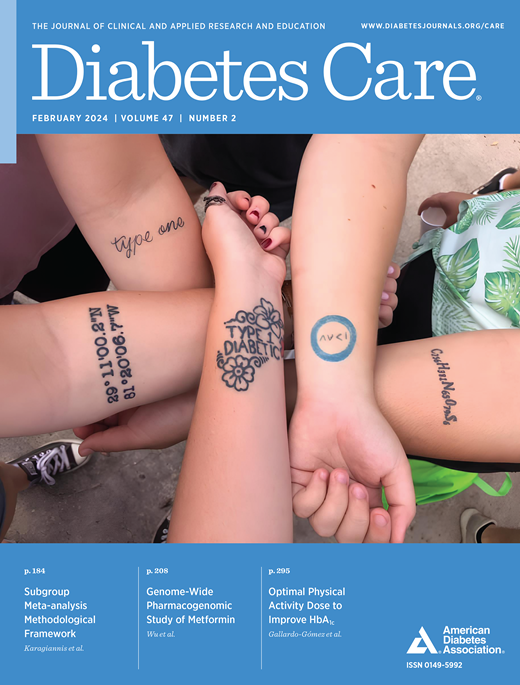不同成人1型糖尿病患者持续血糖指标与瞬间认知表现的动态关系
IF 16.6
1区 医学
Q1 ENDOCRINOLOGY & METABOLISM
引用次数: 0
摘要
尽管血糖和认知之间存在一定的关系,但很少有研究评估人体内随时间的变化。我们将连续血糖监测(CGM)与动态认知测试配对,以检查成人1型糖尿病(T1D)患者的双向关联。研究设计和方法参与者采用盲法CGM,每天完成5或6次感知速度和持续注意力的动态测试,持续14天。在3小时内计算CGM指标(平均葡萄糖,在[70 - 180 mg/dL]范围内的时间百分比,低[70 mg/dL]的时间百分比,高[181-250 mg/dL]的时间百分比,非常高[250 mg/dL]的时间百分比和变异系数)。认知评估后15分钟内的即时血糖值也被检查。动态结构方程模型评估了连续3-h期间的双向关系。结果在182名不同类型的T1D成人(年龄40±14岁,46%男性,41%拉丁裔,29%白人,15%黑人)中,3小时内低血糖时间越长,间隔结束时感知速度越慢(P <;0.05),但3 h后没有。高糖状态(>250)时间越长,最初感知速度越快,但3小时后感知速度越慢(P <;0.05)。体育活动部分介导了高糖对较慢知觉速度的影响。血糖不能预测人的注意力得分。较低的注意力和较高的感知速度预示着在接下来的3小时内较高的平均血糖和处于非常高血糖状态的时间(P <;0.05)。结论:这些关于成年T1D患者一天中血糖和认知表现之间显著双向关联的新观察,强调了在不同时间框架内检查个人纵向影响的重要性。本文章由计算机程序翻译,如有差异,请以英文原文为准。
Dynamic Relationships Among Continuous Glucose Metrics and Momentary Cognitive Performance in Diverse Adults With Type 1 Diabetes
OBJECTIVE Despite established relationships between glycemia and cognition, few studies have evaluated within-person changes over time. We paired continuous glucose monitoring (CGM) with ambulatory cognitive testing to examine bidirectional associations among adults with type 1 diabetes (T1D). RESEARCH DESIGN AND METHODS Participants wore blinded CGM and completed ambulatory tests of perceptual speed and sustained attention five or six times daily for 14 days. CGM metrics were calculated over 3-h periods (mean glucose, %time in range [70–180 mg/dL], %time in low [<70 mg/dL], %time in high [181–250 mg/dL], %time in very high [>250 mg/dL], and coefficient of variation). Immediate glucose values within 15 min of cognitive assessments were also examined. Dynamic structural equation models evaluated bidirectional relationships over sequential 3-h periods. RESULTS Among 182 diverse adults with T1D (age 40 ± 14 years, 46% male, 41% Latino, 29% White, 15% Black), more time in low glucose over 3 h was associated with slower perceptual speed at the end of that interval (P < 0.05) but not 3 h later. More time in high glucose (>250) was associated with faster perceptual speed initially but slower speed 3 h later (P < 0.05). Physical activity partially mediated the effect of high glucose on slower perceptual speed. Glycemia did not predict attention scores within persons. Lower attention and higher perceptual speed predicted higher mean glucose and more time in very high glucose over the following 3 h (P < 0.05). CONCLUSIONS These novel observations of significant bidirectional association between glycemia and cognitive performance over the course of the day among adults with T1D emphasize the importance of examining within-person longitudinal effects over different time frames.
求助全文
通过发布文献求助,成功后即可免费获取论文全文。
去求助
来源期刊

Diabetes Care
医学-内分泌学与代谢
CiteScore
27.80
自引率
4.90%
发文量
449
审稿时长
1 months
期刊介绍:
The journal's overarching mission can be captured by the simple word "Care," reflecting its commitment to enhancing patient well-being. Diabetes Care aims to support better patient care by addressing the comprehensive needs of healthcare professionals dedicated to managing diabetes.
Diabetes Care serves as a valuable resource for healthcare practitioners, aiming to advance knowledge, foster research, and improve diabetes management. The journal publishes original research across various categories, including Clinical Care, Education, Nutrition, Psychosocial Research, Epidemiology, Health Services Research, Emerging Treatments and Technologies, Pathophysiology, Complications, and Cardiovascular and Metabolic Risk. Additionally, Diabetes Care features ADA statements, consensus reports, review articles, letters to the editor, and health/medical news, appealing to a diverse audience of physicians, researchers, psychologists, educators, and other healthcare professionals.
 求助内容:
求助内容: 应助结果提醒方式:
应助结果提醒方式:


